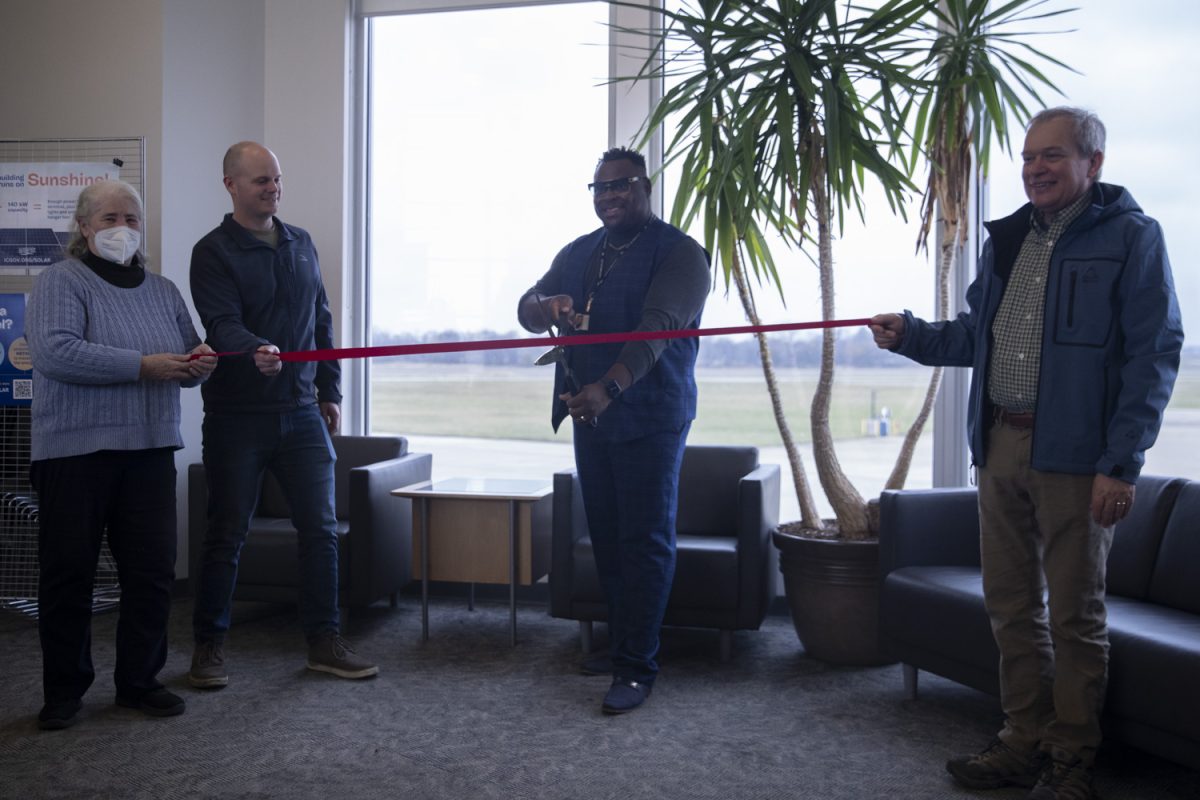The Iowa City Municipal Airport celebrated its new solar array Thursday morning with a ribbon-cutting ceremony. The $1 million project is a culmination of more than a month of construction and an overarching goal of getting the city to net zero carbon emissions by 2050.
Approximately 40 people crowded into a room on the airport terminal’s second floor to hear from Airport Manager Michael Tharp along with Iowa City Mayor Bruce Teague and Iowa City’s Climate Action and Outreach Department Climate Action Coordinator Sarah Gardner.
For more than the last 40 days, workers at the Iowa City Municipal Airport have installed the solar array. Work began on Sept. 23, and the contractor, Solar by Brandt, which originally had 40 days to complete the project, finished it earlier this week. Typically, solar arrays have a lifespan of 30 to 35 years, according to the U.S. Department of Energy.
Small roadblocks prolonged the project, Tharp wrote in an email to The Daily Iowan.
The installed array is the first part of a two-part plan to have solar energy power the municipal airport, paid for with $1.2 million in Federal Aviation Administration funds granted by the 2021 bipartisan infrastructure bill passed by the U.S. Congress.
The airport itself is responsible for $24 million generated in the local economy each year and holds 84 aircrafts, according to its website. The array currently installed generates 104 kilowatt-hours to power the terminal building, runway lighting, and ambulatory building.
Tharp said during the ceremony that, despite the airport’s economic impact on the area, it is still small. Because of this, he said a large project funded by over $1 million in Federal Aviation Administration funds is notable.
“This project for an airport this size is absolutely remarkable,” he said. “It does not come by chance.”
RELATED: Iowa City Municipal Airport to install solar arrays
He also thanked the state, local, and federal governments and helping hands in the airport commission for making the project possible, expressing his relief that years of work had finally culminated.
“I can’t stress enough how happy I am,” he said, “that this project is wrapping up.”
Teague shared his excitement not only in public achievement but also in progress toward the city’s climate action goals, which call for a 45 percent reduction in carbon emissions by 2030 and net-zero emissions by 2050.
Teague is encouraged by the project’s completion, as it represents Iowa City’s commitment to embrace clean, renewable energy. He said the project will help Iowa City reduce its future footprint for facilities and vehicles.
“This solar array not only makes Iowa City a leader on climate action locally, but it also positions us as a role model at the national level,” Teague said.
Solar power and further exploration of renewable energy is vital to a collective well-being, especially considering future generations, he said.
“These ambitious goals are critical for the generations to come,” he said.
Climate Action Coordinator Sarah Gardner said solar power is special because of how it is achieved. The sun is a constant resource and requires no energy to access, she said. The panels themselves are made of glass, glue, and small filaments of wire, a composition that she said is rather simple.
“This means that we have found a way to take sand and glue and just a little bit of metal and harness clean, abundant energy,” Gardner said.
Gardner believes hope is a driving factor in building a better, more sustainable future for all Iowans and for all people. She said the array is a marker for the Iowa City community’s commitment to a better, healthier future.
“Like the sun, like the wind,” she said, “hope in a better future is a renewable resource.”



